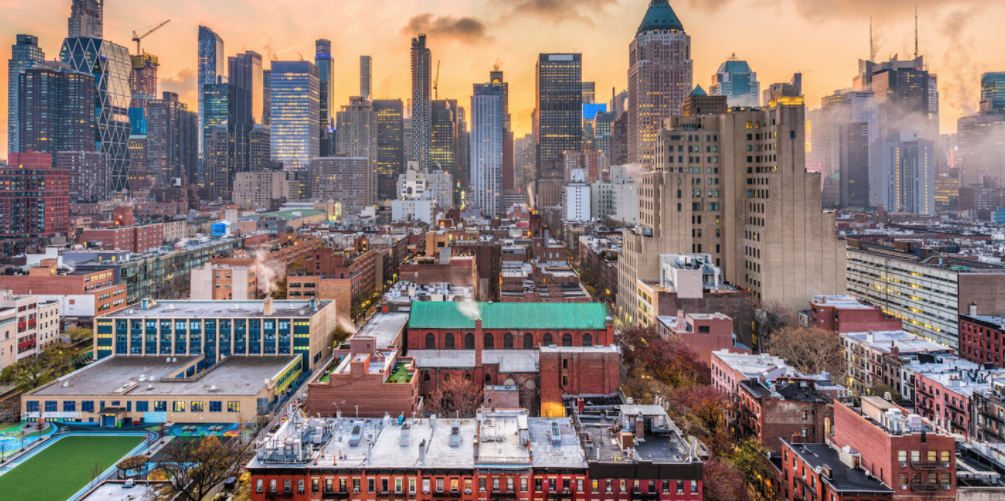2021 Aerial view of Hell’s Kitchen.
In the 1840’s, Hell’s Kitchen was a residential district comprised of African-American laborers for the Croton Aqueduct
1858 “The Hermitage” Samuel L. Norton Residence 43rd Street between Eighth and Ninth Avenues, United States History, Local History & Genealogy Division, The New York Public Library Astor, Lenox and Tilden Foundations.
From the 1850’s, Irish and German immigrants worked along the Hudson River docks, and in slaughterhouses, factories, lumberyards, and warehouses, and construction for the Hudson River Railroad, later renamed the New York Central. Manhattan’s population increase as well as the building boom in the post-Civil War period of the 1860s caused residential growth, from row houses to tenements, in this area. Some of the more well known groups were the West Side Cowboys who worked to clear the path for trains along 10th Avenue and 11th Avenue. The frequency of fatal accidents on 11th Avenue earned it the nickname Death Avenue. Low-rise tenements housed workers and their families. The “Gangs of Youth” fought police and rival gangs.
In the 1860’s, The Landmark Tavern located at 626 11th Ave, citra 1868, stayed open during Prohibition. Late in the decade, piers were constructed north of 40th Street, and several industries were established along the railroad, “including coal yards, breweries, and a sawmill, along with factories producing drainpipes, carpet, and wood kindling. The neighborhood also contained an enormous live hog market, anticipating its future importance as a stockyard and meatpacking center.”
In the 1880’s, twelfth avenue was incomplete, but extensive filling occurred along the shoreline at this point, allowing piers to be built in the West 50s.
In the 1900’s, Carriage Houses were erected to house horses upstairs and carriages on the ground-floor. In addition, attention to the poverty and violence of the neighborhood by Jacob Riis and others led to civic improvements, including the opening of more parks like DeWitt Clinton Park. Also in the time period, a new, mainly African American community, called San Juan Hill, added theaters and nightclubs and spurred the development of ragtime music and jazz. It became NYC’s center of African-American life until it shifted to Harle in the 1910s and 1920s.
In the 1920’s, St. Malachy Roman Catholic Church, a parish of the Roman Catholic Archdiocese of New York, located at West 49th Street, between Broadway and Eighth Avenue, has served the theatre community since 1920, along with the Actors’ Temple, officially named Congregation Ezrath Israel, located at 339 West 47th Street, circa 1923. The Garment Wear Arcade, 18-story office building, circa 1927, spans through the block from 307 West 36th Street to 306 West 37th Streets. As well, the Film Center Building, a 13-story office building, catered to businesses involved in film, theatre, music and audio production and exploitation, at 630 Ninth Avenue between 44th and 45th Streets, circa 1928-29.
In the 1930s, Speakeasies run by gangsters contributed to the removal of Lincoln Tunnel construction leading to reduced numbers of tenements, which continued during the tunnel expansion in the 1940s and 1950s. As a result, the surface railroad tracks on 11th Avenue as well as the Ninth Avenue Elevated train tracks were removed. Afterwards, McGraw-Hill Building, held at 33 stories, located at 330 W. 42nd Street between 8th and 9th Avenues, circa 1931, hailed as New York’s first monument to International Style was constructed.
Post World War II, from the late 1940s onward, lower rent rates attracted new immigrants to Hell’s Kitchen, many from Puerto Rico, and the ensuing conflict was immortalized by the musical “West Side Story” (1957). High rates of violence, attributed to two generations of Irish gangsters, known as “the Westies.” up to the late 1980s.
In the 1949’s, The Port Authority Bus Terminal, at 625 Eighth Avenue between 40th Street and 42nd Street, opened to serve interstate bus travel. Construction for the Bus Terminal and ramps destroyed much of Hell’s Kitchen south of 41st Street
In the 1950’s, Lincoln Tunnel and Lincoln Tunnel access roads to connect New York City to New Jersey. By the end of this decade, developers of the area wanted a better image for the neighborhood, so the city planning committee decided to rename the neighborhood Clinton, named after former mayor and governor DeWitt Clinton. However, both names for the neighborhood continue to be used today.
In the 1970’s, The Javits Convention Center approved for the 44th Street site to replace piers 84 and 86. From Manhattan Plaza, to West 43rd Street between Ninth and 10th Avenues, a federally subsidized rental complex consisting of two 46-story towers, with 70% of the apartments set aside for discounted rent for those who worked in the arts, were credited with turning the neighborhood around. Lee Strasberg taught “method acting” at The Actors Studio on West 44th. Famous actors and entertainers resided in Hell’s Kitchen, including Burt Reynolds, Bob Hope, James Dean, Madonna, Jerry Seinfeld, Alicia Keys, and Sylvester Stallone.
In the 1980’s, Hotels, apartment buildings, and Madison Square Garden, built over the tracks west of Pennsylvania Station, and the Worldwide Plaza complex, constructed in 1989 at the former Madison Square Garden site, covering 49th and 50th Streets, between Eighth and Ninth Avenues. Later, in the late 1980s, many gang members were also imprisoned.
In the 1990’s, the cleanup of Times Square helped lead to the “upscaling” of Hell’s Kitchen.
Since 2000, retail, entertainment, and more than 100 restaurants occupy Ninth Avenue and Tenth Avenue, across the entire length of the neighborhood, and along the Hudson River, the Javits Convention Center occupies several blocks, and the Intrepid Air and Space Museum. Recently, the neighborhood has been undergoing gentrification as it becomes safer and more popular.



